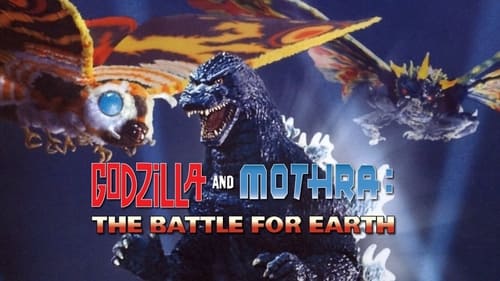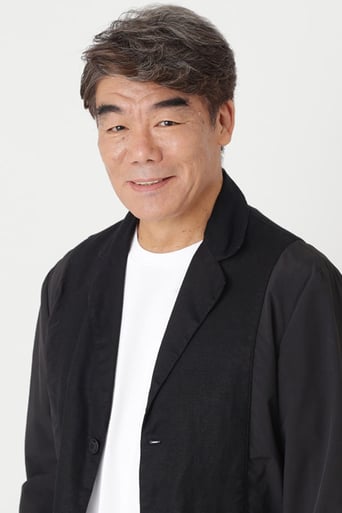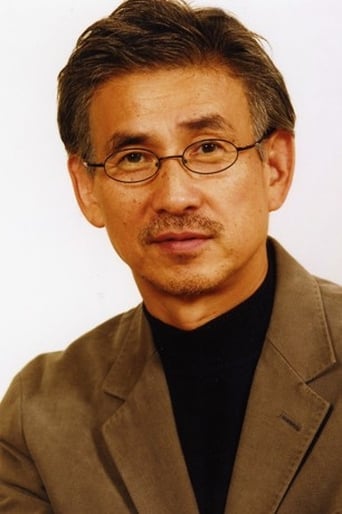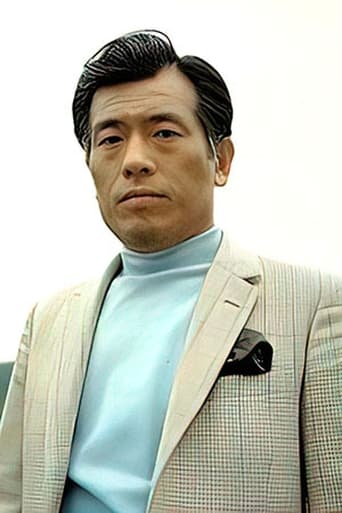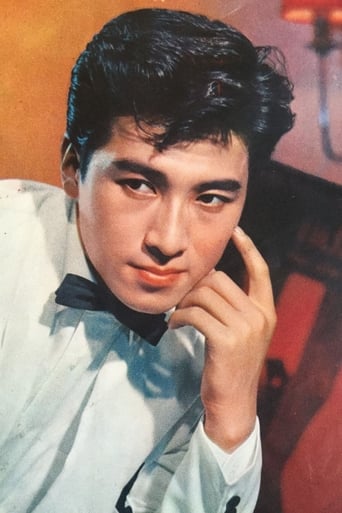Tedfoldol
everything you have heard about this movie is true.
Ketrivie
It isn't all that great, actually. Really cheesy and very predicable of how certain scenes are gonna turn play out. However, I guess that's the charm of it all, because I would consider this one of my guilty pleasures.
Rio Hayward
All of these films share one commonality, that being a kind of emotional center that humanizes a cast of monsters.
Stephanie
There is, somehow, an interesting story here, as well as some good acting. There are also some good scenes
dee.reid
Toho has long recognized that women make up a significant portion of their audience, which is often why women have played such a prominent role in many of the "Godzilla" features that have been released over the decades since the mighty King of the Monsters's debut in "Gojira" (1954). That is why women play such a prominent role in some of the newer "Godzilla" features released between 1984 and 1995.Hence, that is also perhaps why Toho took the chance in 1992 to revive one of the longest-standing staples of its kaiju (monster) library: Mothra, whose name would imply, is a giant moth - a monster-god - with decidedly feminine characteristics. Mothra was not the first female kaiju to appear in the second-generation Heisei-Era "Godzilla" films. That first monster was the horrific yet tragic Biollante, from "Godzilla vs. Biollante" (1989), which I will contend remains the crowning achievement of the Heisei-Era films.Takao Okawara was selected to helm 1992's "Godzilla and Mothra: The Battle for Earth" (or more simply known as "Godzilla vs. Mothra") by Kazuki Ohmori, who wrote and directed both previous Heisei-Era features "Godzilla vs. King Ghidorah" (1991) and the aforementioned "Godzilla vs. Biollante." "The Battle for Earth" is ostensibly a remake of the classic "Godzilla vs. Mothra" (1964), but with a much stronger environmentalist subtext.Things begin with a huge meteor crashing into the Pacific Ocean, setting off a chain reaction of environmental disasters all across the world.The film opens with a direct homage to the timeless opening sequence from "Raiders of the Lost Ark" (1981): Takuya Fujita (Tetsuya Bessho) manages to retrieve a priceless artifact from the ruins of an ancient temple in Thailand, and is promptly arrested for the theft. His ex-wife Masako (Satomi Kobayashi) comes to see him in jail (while also trying to extract delinquent alimony payments out of him), and offers him a chance at freedom: she has talked to the Thai police and they will let him out on the condition that he helps her to locate Infant Island, where a giant egg was recently discovered following a powerful typhoon.It's an offer he'd be stupid to refuse.They travel to Infant Island and find the egg, but also its two protectors - the Cosmos (Keiko Imamura and Sayaka Osawa), two beautiful young girls who are only a few inches in height; they're also the successors to the Shobijin from the first-generation Showa-Era "Godzilla" films, who performed a similar role. They explain that they're the last of an ancient civilization that had once tried to control the weather, and they were protected by their benevolent monster-god Mothra. But they were eventually wiped out during a battle with the malevolent "anti-Mothra" monster Battra, who is described as being the physical manifestation of Earth's innate instinct for self-preservation.Eventually, the enraged Battra is awakened from its eons-long slumber, and he does battle with an even stronger and more menacing Godzilla at sea; Mothra, too, soon joins the fray, after she hatches from her egg - in a sequence referencing a scene from "King Kong vs. Godzilla" (1962). (It must be said that "Godzilla and Mothra: The Battle for Earth" is one of the more visually arresting features of the Heisei-Era "Godzilla" features, highlighted by the strong cinematography and the top-notch special effects by Koichi Kawakita.)It is interesting to note the strong feminine presence in this film. Mothra remains the most prominent female kaiju in Toho's legion of giant monsters. But even more note-worthy with "Godzilla and Mothra: The Battle for Earth" is the strong performances of its human females, Masako and the Cosmos, who both play significant roles in the film's events and don't just stand around doing nothing while all the men do the heavy lifting. There's some romance in here, too, but none of the really gushy stuff we shallow Yanks are so accustomed to on our side of the Pacific. It's also remarkable that the film's two main characters are a bickering divorced couple (rather than scientists or heroic military folks, and who predictably rekindle their love for one another over the course of the film) - one of whom is a criminal, a thief, no less! - but are able to put aside their marital troubles to try to help save humanity. It is a little tragic that essentially Takuya is an adult child who's running away from his familial responsibilities, and ex-wife Masako has to hide the fact from their young daughter that her father is a thief (which is a heavy emotional burden she's none too happy, or willing, to bear).The last and greatest aspect of "Godzilla and Mothra: The Battle for Earth" is the beautiful, elegant film score by Japan's most renowned film composer, Akira Ifukube (who sadly passed away in 2006), and who returned to the "Godzilla" series on the previous entry "Godzilla vs. King Ghidorah." Ifukube's score for this film is just another one of the high points of his incredibly long and illustrious career. It's highly emotional, incredibly evocative of the feelings of the film, and is just an amazing piece of film music to listen to; it truly captures the magnificent beauty of the film, apart from its savage, special effects-laden giant monster battles. And the songs sung by Keiko Imamura and Sayaka Osawa will most likely bring tears to your eyes as they sing their lovely new rendition of "Mothra's Song," as well as the song "The Appearance of Imago Mothra" (which is featured in the spectacular sequence where Mothra emerges as a moth from her cocoon after crashing the National Diet Building - Japan's house of parliament, in case you don't know). I would highly recommend trying to find Ifukube's score somewhere.With its lush visuals, beautiful Akira Ifukube music score and devastating monster battles, "Godzilla and Mothra: The Battle for Earth" is definitely one of the better films from the Heisei-Era "Godzilla" pictures.8/10
winner55
There's no doubt that the strings show on the puppets in this movie; yet exactly for that reason, I suspect this was intentional. The Toho SFX crew isn't stupid - and they've successfully erased the string that wags Godzilla's tail for decades. So I can't imagine that they just slipped up here. I think the strings were supposed to show.Why might they do that? Well let's start by getting real here - the Godzilla series is essentially a series of photographed puppet shows with spectacular explosions. But while most audiences think the emphasis here is on the spectacular explosions (that obviously need excellent SFX to be credible), in reality the emphasis is on "puppet show." Puppeteering is almost a lost art. The Godzilla series arrived at exactly the time historically when professional live-performance puppeteering disappeared from our cultures (West and East), and also at the same time that movie special effects were beginning to crank into high gear. Thus the Godzilla films record the last of professional puppeteering, but in such a way as to obscure that very fact through deployment of extravagant effects.However, if you know what you're doing is recording puppet shows, it's inevitable that you'd want to poke fun at that very fact now and again - and the Godzilla series is filled with such moments, with exception of the first original film.Allowing this film to be a puppet show means that different criteria must be applied to it than are applied to, say, Star Wars or Alien. Appreciation of a puppet show does not require "willing suspension of disbelief" - one can always see the strings. Instead, what the audience enjoys is the skill with which the puppeteer brings inanimate wood to life, as well as the humor puppeteers use to construct all their stories.With this in mind, Godzilla and Mothra Battle for Earth is really a pretty good puppet show. It is beautifully designed and well-photographed; the script is rich in humor; the monsters have strong and well-defined personalities; the back-story is fairly interesting but doesn't detract from the central conflicts; and the music is just wonderful.It is probably not all that a die-hard Godzilla fan might want; but it is certainly the definitive appearance of Mothra.it is really intended for the young - and for the young-at-heart; like all really good puppet shows.I enjoyed it thoroughly, and hope the reader does too; it feels good and, if you recognize what's really going on, it's an important record of a lost art; that makes it good all the way around.
Brandt Sponseller
The film opens with the Japanese Indiana Jones pillaging some archaeological ruins. Just as he makes his way out of a perilously collapsing old temple, he's stopped by rifles pointed at his head. The armed men are from the government, and they're accompanied by his ex-wife. It seems that a strange meteor has crashed near a remote island, and he's been pegged to lead an expedition on the island. They encounter a strange egg, then they run into the Cosmos, two tiny fairy-like beings, who tell them that it's the egg of Mothra, who protects the earth. While taking the egg back to Japan, suddenly, Battra, another monster, shows up, as does Godzilla, in his first appearance of the film, and all hell begins to break loose, as is wont to happen in Godzilla films.That's a bit more detailed than I usually try to present premises (although that's just the first fifteen minutes or so of the film), but I want to give you of how exquisitely bizarre Godzilla vs. Mothra is and at the same time, give some clues as to why I've titled this review "Godzilla vs. Steven Spielberg!" There are all kinds of Spielberg references (occasionally rip-offs) and Spielberg-like touches to this film. But imagine Spielberg on acid, making a live-action adaptation of some wacky kid-oriented anime, with the addition of monsters that are going to rip each other to shreds with death rays emanating from their eyes and mouths and biting each others' necks off while alien-colored blood spews out. That might sound like an atrocious concatenation to some people, but it's heavenly to me, which is why this particular Godzilla film is a 10 out of 10 for me.It's worth noting that director Takao Okawara managed quite a few "poetic" touches in this film, including some beautiful cinematography, the wonderfully weird cocoon-building sequence, and the scene of Mothra flying out into space, trailing sparkly dust. What really works best here, though, is the bizarre combination of kid-oriented fantasy and the more adult-oriented, menacing tone of the typical Godzilla film. The design of Mothra in this film is the perfect example. It looks like somewhat of a cross between a butterfly, a Muppet, a teddy bear, an Ewok, and a Gremlin at their "cute" stage. Only it is a giant fighting monster capable of killing other giant fighting monsters, destroying downtown, or maybe even destroying the Earth. The effect isn't that far removed from the Sta-Puft Marshmallow man at the end of Ghostbusters. It's all wonderfully surreal.
DrLenera
Coming after the terrific Godzilla Vs King Ghidorah,Godzilla Vs Mothra manages to be almost as good. Unlike the previous film,which revived a monster from the older series but structured a new plot around it,Godzilla Vs Mothra is a remake of both the 60s Godzilla Vs Mothra and the original film,Mothra,which introduced the huge moth. Some scenes from those films are copied and sometimes improved,such as the cater pillar Mothra's slide through Tokyo ,destroying everything more by accident than anything else,or the cocooning and hatching of the 'adult' Mothra,which here is a quite beautiful scene. The film provides as much destructive mayhem as the previous film,and visually is even more impressive to look at. The much more cuddly Mothra is a nice touch,while Battra is an awesome menace. Once again,the human characters keep the interest while we wait for the monsters to turn up. Finally,Akira Ikifube's score has the most beautiful piece of music heard in a Godzilla film,actually taken from the first Godzilla Vs Mothra,but sounding much better here.However,the film does have it's problems. The plot is confused,and Godzilla could have almost been removed from the script,he has so little to do with the story. The film rams home it's environmentalist message with all the subtlety of Godzilla,and it becomes a bit tiresome.Nonetheless,another fine Godzilla film,and even if,in the end,it's not quite as good as the original Godzilla Vs Mothra,it's as good an updating as one would have a right to expect.



